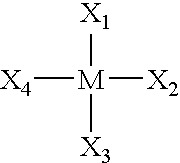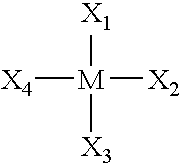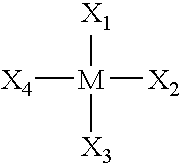Elastomeric urethane composition
- Summary
- Abstract
- Description
- Claims
- Application Information
AI Technical Summary
Benefits of technology
Problems solved by technology
Method used
Image
Examples
examples
[0062]A series of polyurethane elastomers, (Elastomers A through D) are formed using the elastomeric urethane composition of the present invention. The Elastomers A through D are formed via hand-mixing the elastomeric urethane composition including the resin composition, the isocyanate, and the catalyst, in a 400 mL plastic beaker for 20 seconds. The resin composition includes the polyetherol, the catalyst, first and second chain extenders, the chain terminator, and the anti-foaming agent.
[0063]To form Elastomer A, a portion (Portion A) is removed from the hand-mixed elastomeric urethane composition, spread out on a tool heated to 68° C., de-molded after 5 minutes, and allowed to cure for 48 hours at room temperature. To form Elastomers B, C, and D, additional portions (Portions B through D) are removed from the elastomeric urethane composition A molecular sieve is added to Portions B and D, while fumed silica is added to Portions C and D. The molecular sieve and the fumed silica ar...
PUM
| Property | Measurement | Unit |
|---|---|---|
| Fraction | aaaaa | aaaaa |
| Percent by mass | aaaaa | aaaaa |
| Percent by mass | aaaaa | aaaaa |
Abstract
Description
Claims
Application Information
 Login to View More
Login to View More - R&D Engineer
- R&D Manager
- IP Professional
- Industry Leading Data Capabilities
- Powerful AI technology
- Patent DNA Extraction
Browse by: Latest US Patents, China's latest patents, Technical Efficacy Thesaurus, Application Domain, Technology Topic, Popular Technical Reports.
© 2024 PatSnap. All rights reserved.Legal|Privacy policy|Modern Slavery Act Transparency Statement|Sitemap|About US| Contact US: help@patsnap.com










